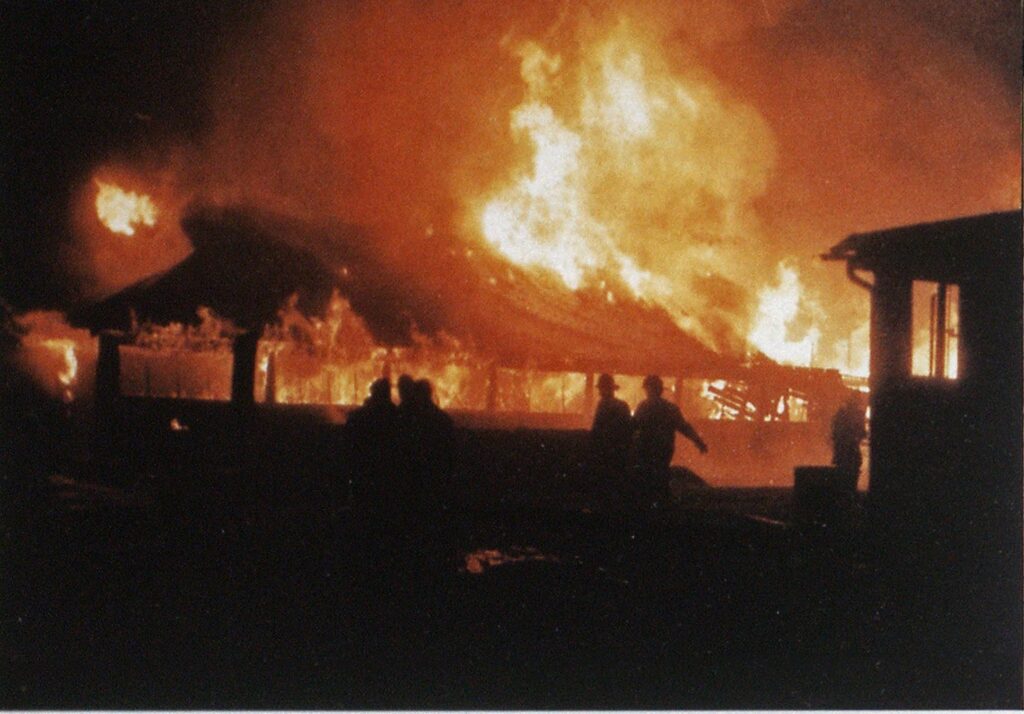
STABLE FIRES: Sad but Preventable
FEATURES
FIRE PREVENTION

Photo by Steve Geraghty
Racetrack Fire Kills 45 Horses
Last January’s fire at Belmont Park in Elmont, NY, said to be “the most lethal ever at a New York racetrack,” killed 45 horses and completely destroyed portions of the 45 X 300 X 20-foot open wood trussed barn, one of 63 such structures at Belmont. The automatic sprinkler system had been shut down for repairs. Total estimated losses were placed at more than $6-million.
Two rows of 30 stalls each were back to back in the center of the stable. Entrance/exit openings were located in the center and at each end of the barn. Hay was stored in open stalls and in lofts over each individual stall.
The fire, believed to have started in an open hay storage stall in the center of the stable, was not considered suspicious, and at presstime was still under investigation.
Although fire forces were operating at the scene within four minutes of the 1:19 A M alarm and had initially confined the fire to a 25foot area, the tinderbox, open construction and a poor water supply greatly hampered firefighting efforts.
After the first-arriving pumper made connections to the nearest on-site hydrant, it was found to be out of service. The second-arriving engine, realizing the water problem, cut through a chain link fence for access to an adjacent municipal hydrant. After proper hookup, the members stretched two handlines to the fire structure. Additional large caliber hose (3inch) was stretched and supplied a ladder pipe to provide needed exposure protection and to be available in the event the fire attack shifted to a defensive mode. Two other engine companies set up an in-line pumping operation from a hydrant on the southwest side of the park to the fire area.
Less than 15 minutes into the operation, a water pressure problem developed, and the department of water supply was immediately notified and ordered to increase pressure in both the Belmont complex and the Jamaica water supply systems.
Because of these problems, flames quickly extended through the roof and horizontally; and due to the extending fire conditions, rescue attempts to save the trapped horses proved impossible. However, fire forces never gave up the structure. The strategy shifted from an offensive aggressive interior attack to an offensive-defensive attack. Handlines continued to be operated inside the east end of the barn, and additional efforts were directed toward exposure protection, the closest exposure being a cottage 15 feet on the north side (Exposure 3) of the fire building. Due to the severe heat radiation, protective streams had to be trained on firefighters and equipment operating close to the fire structure.
The roof collapsed approximately 15 minutes after the initial alarm, and the incident was declared under control at 2:10 A M. Firefighters succeeded in saving all exposures and 125 feet of the barn from fire damage.
In retrospect, the confusion in the initial stages of the firefight could have been lessened had the racetrack notified the fire department of the out-of-service sprinklers and hydrant. Although security patrols were increased near the barn because of the sprinkler shutdown, a firewatch should have been initiated as well.
This stable, like so many others throughout the country, was built well before the 1979 National Fire Protection Association (NFPA) Standard on Fire Safety in Racetrack Stables (NFPA 150-1979) was instituted.
Of course, this standard only sets forth the minimum requirements that must be met for a fire protected stable. Some other suggestions for preventing barn fires which should be discussed with horseowners during inspections and preplanning sessions are offered in the following article.


